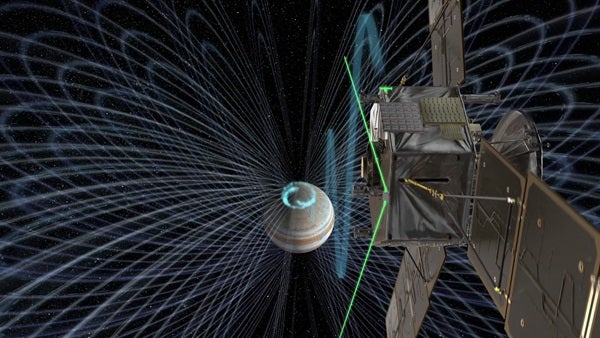Juno is the fastest spacecraft to enter orbit around another planet. But is it really the fastest spacecraft ever? When it comes to velocity, that depends on how you measure it.
When the Juno spacecraft entered orbit around Jupiter on July 4, 2016, it set all sorts of records: Farthest operational solar-powered spacecraft, first spacecraft to enter polar orbit around another planet, first spacecraft with 3D-printed parts, and first spacecraft with a titanium vault to offer protection from radiation. But did it also set a speed record? Yes and no.
To tear free from the gravitational clutches of the Earth, a spacecraft needs to hit a bare minimum velocity — the escape velocity. This initial speed comes from a ferociously powerful launch. The New Horizons spacecraft holds the record for the fastest launch, but it didn’t pull many tricks to pick up speed on its way to Pluto and beyond into the Kuiper Belt.
At over five times the mass of New Horizons, Juno was going far slower when it was relinquished by its launch rocket. But the spacecraft added to that initial velocity by dipping back into Earth’s gravitational well, stealing a bit of that potential energy for its journey and boosting its speed by 7,300 meters per second (16,330mph). Closing in on Jupiter, Juno surrendered to the gas giant’s gravitational pull, falling in until it reached a peak velocity of 57,900 meters per second (130,000 mph) by the time it started braking to make orbit. This made Juno the fastest object to ever enter orbit around another planet, relative to Earth.
That last phrase is important. The entire universe is moving relative to something, so what are we using as the fixed point to measure the spacecraft’s motion? John Bordi and Tom Pavlak, navigators for the Juno mission, explain in an email, “Velocity is always measured relative to something.” On Earth, that’s easy: measure relative to the starting point. But as astrophysicist Jonathan McDowell explains, “Everyday concepts don’t have a meaning when you change context.”
For things inside Earth’s gravitational influence, it makes sense to use our home planet as reference by treating it as a fixed point in space. But for anything that breaks free and travels beyond the Lagrange points — points of gravitational equilibrium between the Earth and Sun — it stops making sense to reference an object that is itself whirling around the Sun at 30,000 meters per second (67,100 mph).
Instead, spacecraft velocity is measured relative to the Sun. Bordi and Pavlak explain, “For interplanetary missions, this is kind of a natural way to look at things, since the planets and the spacecraft are all orbiting the Sun.”
McDowell agrees, explaining in a telephone call, “[Interplanetary spacecraft] speed relative to the Earth is dominated by the Earth whizzing back and forth around the Sun.”
When measured relative to the Sun, suddenly Juno doesn’t look so impressive. At this particular moment in Earth’s orbit, the geocentric and heliocentric velocities are nearly the same for the spacecraft. While fast, that’s mere plodding compared to Helios 1 and 2, a pair of probes that orbited the Sun in the 1970s and 80s. While it was still functional, Helios 1 set a speed record of 66,000 meters per second (147,600 mph) measured relative to the Sun, or a scorching 96,200 meters per second (215,200 mph) relative to the Earth during just the right point of its orbit.
Juno will manage to get even faster during its second orbit around Jupiter, hitting an estimated 75,000 meters per second (167,770 mph) relative to Earth. But even then, it’ll be beaten out for speed records by Helios 2 (92,720 meters per second), Messenger (91,090 meters per second), and probably even Mariner 10 (estimated 80,000 meters per second). Why do all these spacecraft in the inner solar system hold the speed records when deep space probes need to travel so much further? Anything in solar orbit is falling around the sun. “The closer you are to the Sun, the stronger its gravity is and the more it pulls you, so the faster you fall,” McDowell explains, continuing, “So the orbital speeds get bigger deeper into the gravity well.”
This is going to be even more true for spacecraft of the future. Solar Probe Plus is scheduled to launch in July 2018, daring to skim closer to the Sun than any spacecraft before. When it does, it’ll set all new records with a velocity of over 200,000 meters per second (450,000 mph) relative to the Sun. And then it truly will be the fastest spacecraft, no matter how you measure it.










